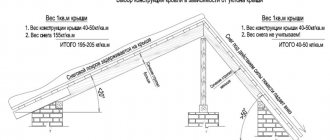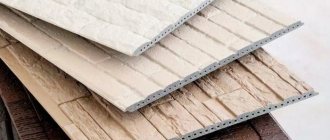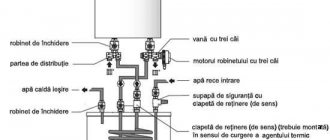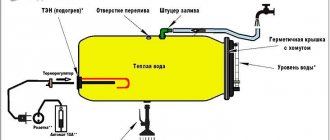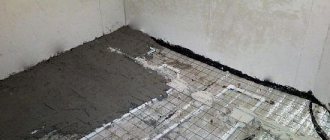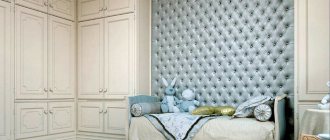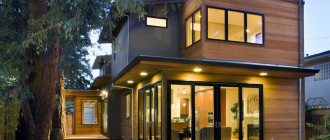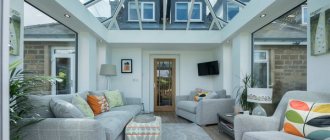Roofing work includes a whole range of activities, the quality of which determines the reliability of the entire structure. This includes the construction of the rafter system, the arrangement of the pie, and, of course, the installation of the covering.
The material that protects the roof and under-roof space from the influence of the external environment must have decent characteristics ( strength, durability, etc. ).
And aesthetic properties play an important role in this matter, because who doesn’t want to see their home neat and attractive.
When choosing a roofing covering taking into account the specified criteria, it is worth taking a closer look at composite tiles. This is a relatively new material that imitates natural tile roofing , the basis of which is thin-sheet steel equipped with a special coating.
We bring to your attention alternative types of tiles:
- polymer-sand;
- flexible (soft);
- cement-sand;
- metal tiles;
- natural ceramic;
Types of composite tiles
On sale you can find different types of products supplied to the construction market by various manufacturers:
- Composite tile metrotile . A Belgian company that began close cooperation with the Russian Federation in 2002. All products entering the Russian market have the necessary certificates and quality marks. The material consists of a steel sheet, which is coated on both sides with a layer of aluminum-zinc. The result is a durable, corrosion-resistant product. Stone chips, fixed using a special product produced by Metrotile, additionally protect the panels from the influence of the external environment. And the top layer (acrylic glaze) gives the product self-cleaning properties - dirt is washed off from the surface when it rains. The company produces various profiles (composite tiles Metrobond, MetroClassik, MetroShake, etc.).
- Composite tiles luxard . One of the leading manufacturers of this type of tile in Russia and the CIS countries is. Made from hot-dip galvanized steel. The sheets are covered with several layers of different materials, each of which performs its own function. Roofing "Luxard" is a material that combines the strength of metal, resistance to aggressive environments and high aesthetic properties.
- Composite tiles gerard . The material is produced by the New Zealand company Ahi Roofing. The company produces various tile profiles (Classic, Heritage, Shake, etc.), imitating different materials (ceramic tiles, cedar shingles, wooden shingles). The coating is available in 12 color shades and 7 mixed colors (two-color) . Like all other types of ceramic tiles, “Gerard” consists of a steel sheet and several different layers that form a high-quality coating.
- Decra . Produced by the famous Finnish manufacturer of roofing systems - Icopal, which has been operating in the Russian Federation since 2005. Today, composite decra tiles are in definite demand on the Russian market due to their positive characteristics ( strength, frost resistance, fire safety ). The manufacturer produces tiles of various shapes and colors (Classic, Stratos, Roman, Elegance). The full range of composite tiles can be found on the company’s official website https://www.icopal-russia.ru/kompozitnaia-cherepitsa-decra/.
- FEROOF . A South Korean company that produces premium composite tiles. The products are distinguished by proprietary technological developments and individual design . The material is presented in several types (RIO, ZISSEN, DIVA, WOOD, VENETO), having a variety of colors and shapes.
Metrotile composite tiles
Gerard tiles
Roof tiles Luxard
Decra
Feroof
Popular brands: advantages and new products
The ability to navigate the composite tile market is important because... Different factories differ not only in manufacturing technologies, but also in the testing process of their own products.
For example, German manufacturers put their tiles through 150 cycles - this is the standard, but they only provide a 30-year guarantee, as is customary in their country. True, for Russia it was increased to 50 years.
Let's look at offers from popular manufacturers - what is the highlight of each product?
Metrotile: natural basalt topping
Let's start with the most popular, expensive and first brand of composite tiles for the Russian market - Metrotile. These Belgian tiles are made from particularly flexible Luxembourg steel, making them suitable for roofs with almost any surface:
Here is the composition of Metrotile roofing sheet:
- On top is a transparent acrylic glaze, which helps clean the roof from dust during rain.
- Next comes granulate of natural stone - basalt.
- The next layer is acrylic, which fixes the natural sprinkles.
- The sheet is based on aluzinc, 190 UAH/m2, with a metal thickness of 0.45.
- The penultimate one is an acrylic primer, as an additional anti-corrosion protection for the metal sheet.
- And in the very heart is aluminum zinc, steel 9 mm thick. It is produced for Metrotile by Luxembourg, a special brand that is known for its excellent flexibility and stretchability.
Serious approach!
Metrotile also pleases its customers with an interesting installation method: you need to apply a drop of vulcanizing paint from a special tube to the nail head and wait 10 minutes (experienced roofers hammer 10 nails and then drop drops on them, the whole task takes no more than 5-10 minutes) . This way the cap fuses with the surrounding topping and disappears against the background of the entire coating. It is no longer possible to find it later or tear it off.
Here is a very interesting video about exactly how Metrotile tiles are produced and what layers they consist of:
Roser: smart technologies and trade secrets
South Korean tiles from Roser are a complete mystery to other manufacturers, because their manufacturing technologies are strictly confidential and patented. But buyers especially like the fasteners from Roser - without through holes.
It uses a rubber washer and a screw, which seems more durable than just nails. Although there are also opponents of this method, they believe that all this will begin to occur within 5-10 years, if we take into account the experience with ordinary metal tiles. Roser offers a metal thickness of 0.45.
Gerard: New Zealand materials
Another good tile is produced by Gerard, the New Zealand company Ahi Roofing, but the production itself is located in America and Europe. As a basalt topping, Gerard uses crushed stone, which is mined in New Zealand quarries, with a natural color. Over time, this color plays with new shades, quite picturesquely.
For products that will be sold in Europe, Gerard built a plant in Hungary, but both chips and profiled sheets are still imported from New Zealand. Sheet coating – aluzinc, 150 g/m2, thickness 0.45.
For installation of its products, Gerard supplies special nails that are coated with acrylic glaze. Moreover, according to the manufacturer, with mechanical action on the nail, this acrylic coating heats up slightly and, as it were, “sinters” with the base acrylic.
It turns out that the hole from the nail is tightened, hermetically closed and protected from leaks. In addition, today they have come up with a special mount that is loaded into a pneumatic gun and the installation of the tiles occurs very quickly.
Decra from Icopal: Finnish quality
Composite tiles from the company Dekra, which works under the supervision of Ikopal, are also good:
Decra composite tiles have been used all over the world for almost half a century, since 1973, so its quality has been confirmed by practice, and not just by laboratory tests. What is the difference?
The fact is that even with hundreds of defrost-freeze cycles or winds, temperature changes, a new, just released sample is tested in the factory. But on a real roof, all these cycles, only now natural, expose not new tiles, but those worn out by time, the sun and random traumatic facts. This is why Decra is today the leader in the European roofing market.
Decra is based on aluminum zinc with epoxy composite, which has a high degree of adhesion. An additional layer is made of acrylic mass with increased mechanical strength. Last comes a topping made of natural stone and acrylic varnish, which has been designed to be UV resistant. Plus, this whole layer of different composition increases the noise absorption coefficient.
Decra's design is always single-wave, and always with imitation of elite, natural and ceramic tiles. And the installation is unusual: under the lower end of the wave, which avoids leaks where the screws are.
Kami Terra Plegel: Swedish quality
When choosing, pay attention to the Swedish tiles Kami Terra Plegel, which is rightfully considered the Swedish leader in the production of metal roofing materials, on the Russian market since 1996, and the company itself has been operating since 1976.
The basis of such tiles is steel with a thickness of 0.5 to 0.9 mm, which is coated on both sides with a layer of zinc of 275 g/m2. Thanks to such a generous zinc coating, such a roof is resistant to temperature changes from -40°C to +120°C, can withstand physical loads of up to 300 kg and wind loads of up to 250 km/h. But here lies an unpleasant point: it is this manufacturer that produces composite tiles without aluminum zinc.
Luxard from TechnoNIKOL: new products on the market
But you've probably heard of the Russian company TechnoNIKOL. She has quite decent composite tiles, which are produced under the Luxard brand:
The metal thickness of such tiles is 0.5 mm (and not 0.45 mm, like many other manufacturers), with an aluminum-zinc coating. The only drawback is the price, because many people expect a more friendly pricing policy from domestic roofing.
Composite tiles: pros and cons
Like any other product, the type of roofing under consideration has its pros and cons. The advantages of composite tiles include the following features:
- resistance to corrosion , thanks to the aluminum-zinc coating (however, an important condition here is correct installation);
- light weight and fire safety;
- large selection of shapes and colors ;
- the flexibility and ability to cut the material allow it to be used to cover roofs of various configurations;
- resistance to temperature changes;
- high water resistance ;
- guarantee 30-50 years;
- the basalt layer reduces noise from rain and hail .
Flaws:
- high price ;
- If installed incorrectly, there is a risk of corrosion ;
- It is not recommended to frequently walk on such a coating , as this can lead to roof leaks.
How to care for composite roofing
Each manufacturer includes instructions with the material kit, which contain recommendations for installation and operation of the coating. If there are no such instructions, then advice can be found on the manufacturer’s website. Professional craftsmen give the following recommendations:
- the use of copper elements in the roof structure should be excluded, since upon contact with this metal, composite tiles quickly rust and crack;
- dented and deformed panels must be promptly replaced with new ones, which will avoid rust and moisture getting under the coating;
- Contaminants are removed with a mild soap solution; aggressive components should not be used. It is also forbidden to rub the surface with hard sponges;
- minor scratches are removed with a special repair kit, which contains all the necessary products and is sold in construction supply stores;
- If you need to walk on the roof during repairs, you should use shoes with soft soles that cannot scratch the coating.
Composite tiles combine the properties of metal and natural stone and are supplemented with protective components. Therefore, the characteristics of the material exceed the properties of ceramic and other types of roofing coatings. At the same time, the installation of composite panels is quite simple, which makes the material in demand for private houses and non-residential buildings.
Specifications
Regardless of the type, composite tiles have a structure consisting of several layers . The basis of the material is a sheet of steel (thickness 0.3-0.5 mm), coated on both sides with a layer of an alloy of aluminum, zinc and silicon. On the outside, an acrylic composition and natural stone chips (jade, jasper, basalt, quartz) are applied to the aluminum-zinc surface, which are coated with acrylic glaze. The back side of the aluminum-zinc-coated sheet is treated with an acrylic primer.
Structure of the coating
The presence of zinc in the composition of the tiles makes the material resistant to mechanical damage, cracks and scratches. The top glaze layer protects the product from exposure to ultraviolet radiation , so the coating retains its original color for a long time.
The sheet sizes of composite tiles may vary from manufacturer to manufacturer, but the difference between them is small:
- length - 1.36 meters ;
- width - 0.42 m ;
- The weight of the product is 6-7 kg/m2 .
Features of plastic tiles
The main components of plastic tiles are the following:
- Dyes are mineral-based pigments;
- Polymers;
- Quartz sand;
- Additives that prevent the material from igniting and ultraviolet stabilizers that protect the tiles from the effects of sunlight.
The production technology of this material is similar to the production of natural tiles, but cement was excluded from the composition, and instead they began to add a thermoplastic type polymer - polyethylene.
Features of the production of plastic tiles are shown in the video:
Thanks to the stamping production method, plastic tiles are produced in various colors and specified geometric parameters.
Roofing pie device
A cold roof is a simpler structure and, in addition to the rafter system, includes only the covering material itself and a waterproofing membrane, which is laid under the tiles.
First, the film is fixed with a construction stapler, after which it is finally secured with self-tapping screws for the grille. The fixed canvas should sag slightly (1-2.5 cm), which will provide ventilation and drainage of condensate into the gutter.
IMPORTANT!
The design of the roofing pie depends on the intended structure of the roof itself (whether it will be a cold or warm structure).
A sheathing is attached to the counter-lattice, on which the composite tiles are laid.
A warm roof consists of the following elements (photo of the pie diagram below):
- A vapor barrier film that protects the insulation from steam penetration from inside the room.
- Rafter system.
- Thermal insulation layer, which is mounted between the rafters, leaving space for ventilation.
- Waterproofing membrane. The material is laid with a sag of 4-5 cm, while the same distance should remain between it and the insulation.
- Counter-lattice. It is installed along the rafters and presses the waterproofing.
- Lathing. It is attached to the counter-lattice and serves as the basis for the roof covering.
Roofing pie
Saving
Composite roofing is a premium product. The roofing covering has the appropriate quality, appearance and service life.
Composite tiles at a price per m² are considered an expensive coating, but when compared with other options, savings are revealed on the following aspects of construction:
- There is no need to purchase under-roofing accessories, which include not only roofing fans, but also OSB boards, plus underlay carpet (mandatory for soft tiles), various seals and corrugated tapes. The same goes for snow guards.
- You will save on strengthening the rafter system due to its light weight. The recommended, but not minimum, rafter spacing for a composite roof is 1200 mm under a 50x50 mm sheathing. This is significantly less than a pitch of 800 for ordinary ceramic tiles measuring 430x260 mm.
- Inexpensive delivery. The average sheet size is 1335x400 mm; about 175 m² of usable coverage area fits into a pallet. To transport the material to the construction site, an ordinary Gazelle or even a pickup truck will suffice. There is no comparison with the cement-sand or ceramic analogue: for the same 175 m² you need 5-7 pallets and delivery by heavy truck.
Delivery of composite tiles by pickup truck to the site Source gerardroofs.eu
It is important to note that the price of composite tiles is also affected by the cost of transporting the material from the factory in Europe to Russia. Due to the compactness of the material, composite tiles, which can be bought in St. Petersburg, Moscow and other cities of Russia, cost almost the same as at a factory in Europe. For example, due to the inevitable extra charge for transporting ceramic tiles, in Russia its cost increases by 30-40%.
Purchasing composite materials is an investment in the future. It's no secret that many budget roofs need to be redone after 10-15 years. This option is quite acceptable for the construction of an outbuilding or gazebo, but is not suitable for such a permanent structure as a country house.
When installed in accordance with all the rules, the original tiles will last the entire guaranteed period. This is the most significant part of the savings, because the cost of remodeling is always higher than installing a new roof. By buying economy class material, after 10-15 years you doom yourself not only to purchase and install a new one, but also to dismantle the old coating.
Converting deteriorated bitumen shingles to composite ones Source gerardroofs.eu
Strict hip roof design Source gerardroofs.eu
Roof angle
The recommended slope slope for composite tiles of the luxard classic brand and others is in the range from 15 to 90 degrees .
If waterproofing a roof with a slight slope (up to 20 degrees), it is necessary to use additional waterproofing materials .
On slopes with a slope of up to 15 degrees, the tiles are laid on a continuous flooring using roll waterproofing.
Under such conditions, the coating is only decorative.
Appearance: what are we looking at?
The roof is one of the fundamental elements of the house, both from a constructive and aesthetic point of view, and we evaluate any house not only by its materials, but also by their color. The design of composite tiles is carefully thought out and takes into account modern color trends. You can choose the material for a house of any architectural style if its roof is pitched.
Composite tiles are offered by the manufacturer in collections. Each of them features composite tiles of a certain texture and a variety of colors, determined by the stone topping. The appearance and price of composite tiles depends on the texture.
It is convenient to divide the collections into the following categories:
- Wavy . The design is based on the traditional aesthetics of ceramic tiles, so the appearance of such a roof on a house is indistinguishable from a natural clay structure. Since it is not necessary to install snow guards on composite shingles, the roof looks even more natural and attractive.
Diamond composite tiles on a hipped roof Source gerardroofs.eu
Heritage composite tiles on a hip roof with a “cuckoo” element Source gerardroofs.eu
Milano composite tiles on a complex roof Source gerardroofs.eu
- Low profile . Samples from these collections recreate natural textures, such as slate roofing and cedar shingles. The design looks exclusive and harmoniously combines with both wooden and brick facades.
Sheik tiles on a wooden house Source gerardroofs.eu
Sheik tiles on a house with a brick facade Source gerardroofs.eu
Relief texture of natural stone Source gerardroofs.eu
Choosing which composite tile to buy is relatively simple, since its color palette is limited to 25 colors. Compared to standard metal tiles, for which about 1600 shades of the RAL scale are used, this is not much. This is explained by the fact that in the production of the original composite roofing, natural stone topping is used. The material is not dyed and has a natural color that is resistant to fading.
The range of colors is quite diverse and is presented in stylish natural shades: from charcoal gray and dark brown, to brick red and even Mediterranean coral. When choosing composite tiles at a price per m², keep in mind that there are unusual and quite rare options, for example, sapphire or dark green stone colors.
Color palette of natural stones Source gerardroofs.eu
Calculation of the number of tiles
The number of tile panels depends on the area of the slopes, the shape of the roof and the type of tiles (different types have different usable area).
To calculate the amount of material, you need to divide the roof area by the usable area of the tile sheet and add 5% to the resulting value (the recommended supply of material). The final result is rounded up to whole numbers.
Calculation example:
- The total roof area is 200 m2.
- The useful area of a sheet of MetroBond tiles is 0.46 m2.
- Amount of material = 200/0.46 + 5% = 434.78… + 21.73…. = 457 pcs.
Experts also recommend paying attention to:
- for uniformity and uniformity of color. In the photographs presented, which depict the work performed by the company, you can notice either a uniform color (and this indicates good quality), or changes in shade from tile to tile, which indicates low quality dyes or polymers;
- on the surface texture - it should be smooth;
- for the correct geometric shape and smooth edges of the tiles;
- by weight Too much weight indicated for this type of coating indicates an insufficient amount of the polymer component. Normally, the weight should not exceed 22 kg/sq. m.
In addition, aesthetically attractive tiles are superior in many respects when compared with natural ones; at the same time, they are much heavier than metal tiles and more expensive than sheet roofing materials.
Preparing the sheathing
, wooden blocks measuring 50x50 mm are suitable for constructing the sheathing . If the distance between the rafters is greater, thicker beams should be used.
When installing the bottom beam, 2 cm are removed from the edge of the counter-lattice . The length of the sheathing parts should be a little more than two meters - this is necessary so that the beams cover at least two spans of rafters.
NOTE!
The pitch between the slats should be equal to the useful length of the tile panel . This is necessary to create a lock between the covering elements, which will provide high-quality waterproofing and protection from the wind.
The top row of sheathing is mounted taking into account the shape of the ridge. So, for a semicircular product “Metrotile” the distance between the outer edges of the bars located on both sides of the ridge is 13 cm, for the ribbed one – 12 cm . These values may vary depending on the size (width of the shelf) of the ridge.
Lathing step
Disadvantages of the material
This type of roofing, in fact, has one drawback, in addition - a conditional one . The cost of such material cannot be called publicly available.
But sometimes the disadvantages include the possibility of lichen or moss appearing on the roof. Although the surface is rough, the acrylic outer coating usually leaves no chance for any type of vegetation. Therefore, these fears can be called unfounded.
Shedding of the decorative mineral layer or its fading may occur, but the reason will be hidden in the purchase of low-quality products. If you buy high-quality composite tiles, then it is impossible to encounter such a drawback . Manufacturers provide a guarantee for decades of operation, but in reality such a roof lasts much longer.
Installation of composite tiles
- The covering sheets are laid overlapping, from top to bottom . Only the first row is attached to the upper edge of the sheet.
- The second panel is laid under the first and nailed with anodized nails in four places .
- The next row is placed under the top one and both rows are secured by driving nails into the end of the sheet of the upper segment. Since the tiles have a rough surface, the nail heads should be painted with weather-resistant paint and sprinkled with mineral stones included in the repair kit.
- The panels are laid in a checkerboard pattern, shifting the rows left and right. In places where there are overlaps, no more than 3 sheets should meet . If the tiles are installed with an overlap on the eaves, the bottom row is fastened with nails from above.
- After installing the tiles, work is carried out to arrange the junction of the roof with the chimney, walls, ventilation pipes, etc.
- In general, the installation instructions for composite tiles are very similar to the installation process for metal tiles.
CAREFULLY!
cut the tiles with a jigsaw equipped with a fine-toothed metal file.
Installation of tiles
Sheet installation diagram
What are the performance features of this roofing material?
The specific structure of high-quality composite tiles determines the variety of its obvious advantages and some disadvantages.
What are the advantages of the material?
- The beauty of the resulting roof . This is perhaps one of the main reasons that encourages consumers to purchase such roofing material. In principle, it is difficult to compare with tiles in terms of external attractiveness to any other coating, and in the case of composite roofing, the developer is offered a lot of options to choose from: from classics that take you back to the era of antiquity or the early Middle Ages, to modern minimalist styles.
The variety of composite tile options offered for sale can even confuse you - which model to choose, they are all so good!
In a word, when it comes to the decorative quality of the resulting roof, tile roofing (including composite) usually has few competitors.
- Beauty is beauty, but you can choose natural tiles based on this criterion... And here one of the most important advantages of such a composite coating manifests itself - it is almost six times lighter than classic ceramic tiles . And this immediately entails a lot of other advantages - the construction of the rafter system and roof sheathing becomes easier, there is no unnecessary load on the walls and foundation of the building, the issues of transportation, loading and unloading of material are significantly simplified - and other aspects of a similar plan.
Laying such roofing usually does not take too much time and does not involve complex technological operations
- Another important difference from natural tiles is their very convenient size for installation . Agree that laying piece coverings is much more difficult and time consuming than sheets, each of which immediately covers about 0.5 square meters.
Sheets of composite tiles can cover about half a meter of area at once, and at the same time they are not so large and bulky as to complicate installation work.
At the same time, the sheet size cannot be called too large. But this is also important - it greatly simplifies the supply of material to the top, working with it on steep slopes, cutting operations are minimized, and a minimum amount of material is wasted.
- High-quality composite tiles are famous for their reliability . The metal has excellent protection against corrosion, and the decorative “finishing” of the roof is completely covered with an acrylic transparent layer that is not afraid of aggressive chemical influences and mechanical damage. It is not for nothing that leading manufacturers are not afraid to provide their products with a guarantee of impeccable service of 30–50 years.
Thoughtful protection against ultraviolet exposure will preserve the brightness of the decorative colors of the roofing - it will not fade or lose its “freshness,” as often happens with roofs made of ordinary corrugated sheets, roofing steel or metal tiles.
Prices for corrugated sheets
corrugated sheet
- The basis of composite tiles is still a steel sheet, which is highly resistant to mechanical stress . Videos and pictures of comparative “crash tests” of piece tiles (ceramic or polymer-sand) and composite tiles are circulating on the Internet. The laid out roofing fragments are simply “shot” with stones, and the results of such a test are clearly not in favor of piece materials.
An illustrative example - it is almost impossible to pierce a composite tile through impact -
Expert opinion: Afanasyev E.V.
Chief editor of the Stroyday.ru project. Engineer.
A strong impact may cause a dent, a deep scratch, or damage to the integrity of the decorative coating on the composite tiles, but there will be no through holes from such an impact. Such defects are certainly unpleasant in themselves, but in any case, the roof will not leak because of this.
It is clear that flying stones rarely hit the roof (although there are plenty of people with mental anomalies everywhere...) But, for example, large hail or falling broken branches of large trees can pose a serious threat. For composite tiles this does not pose any particular danger.
- Since we are talking about the advantages of the metal base of composite tiles, we cannot fail to mention its plasticity . This can be important when installing roofing coverings on roofs of complex configurations, for example, those with smooth wave or arc-shaped transitions.
Sheets of composite tiles, due to their metal base, have a certain plasticity.
This opens up additional opportunities when carrying out roofing work on difficult areas of the roof. If you have appropriate experience in roofing work, you can cover such areas without additional cutting of material and without complicating the truss structure. Look at the illustrations above - doesn’t it look very original? And at the same time, the roof is absolutely reliable, since in difficult areas solid sheets of composite tiles are used, that is, there are no unnecessary joints of the material.
- This material not only weighs a little, but is also very compact - as a rule, you can deliver all the required amount of composite tiles (with all the required additional profile elements) for installing the roof of a fairly large mansion in one “walk” in a small truck.
- Unlike conventional metal sheet roofing materials, composite shingles are not a “noisy” roofing material . The multilayer structure, coupled with a mineral coating, makes this roof very effective at dampening noise from heavy rain or hail.
Even in a very heavy downpour or during a hailstorm, a roof made of composite tiles will not turn into a rattling “drum”
- Unlike purely metal roofing coverings and ceramic tiles, the composite roofing in question has low thermal conductivity , that is, it behaves very well in different temperature conditions - both in the cold and in the intense summer heat. It does not heat up excessively in the sun, does not accumulate either excess heat or cold, that is, its presence does not affect the reduction in the comfort of the microclimate in the attic.
- Composite tiles are safe from a fire safety point of view. Moreover, some manufacturers of such high-quality roofing material directly position it as a fire-resistant coating.
Composite tiles are associated not just with non-flammable, but even with fire-resistant roofing coverings that can, in certain situations, stop the spread of flames, and thereby save the house from fire.
Even when heated to high temperatures, the materials used in the manufacture of such tiles will not spread fire and will not emit toxic combustion products hazardous to human health. This advantage will be even more pronounced if high-quality thermal insulation mats (slabs) based on absolutely non-flammable and heat-resistant basalt wool are used to insulate the roof (attic).
On top there is a composite tile, on the bottom there is a layer of thermal insulation made of high-quality basalt insulation. The problems of fire safety, effective insulation and almost complete sound insulation of the roof are solved at once.
- The material is completely “clean” from an environmental point of view - it does not pose any danger either to those living in the house or to the environment. Moreover, this quality does not depend in any way on the conditions and duration of operation of such a roof.
- One more advantage can be added. If you look at the slopes of roofs covered with composite tiles, you will find that many of them do not have snow barriers.
On roof slopes covered with composite tiles, you most often will not find snow barriers - there is no particular need for them.
The thing is that there is practically no need for such devices. The “crossed” surface of the tiled roof, coupled with its roughness, does not allow snow drifts during heavy snowfall or thawing during a thaw to “sink” down on their own, tearing off the gutters or creating a danger for people. The snow will gradually settle until it completely melts.
Prices for metal tiles
metal tiles
Composite tiles are always accompanied by a wide range of additional parts made in the same decorative style
Manufacturers of composite tiles provide it with the necessary fittings, strips and profiles, ridge and valley parts, special fasteners and much more - everything that is required for installing a high-quality and harmoniously looking roofing covering on a roof of any degree of complexity.
What do you need to know about the disadvantages?
- To be honest, this type of roofing has only one serious drawback, and even then it is very conditional. We are talking about the price of composite tiles, which, alas, cannot yet be called publicly available.
Moreover, even among different manufacturers of this material, very significant differences in the cost of products can be traced, with seemingly equal or similar parameters. The reason for this phenomenon is known - consumers often have to pay extra “for the brand,” that is, for the brand, which in itself often plays the role of a guarantee of quality and durability.
- Disadvantages sometimes include the likelihood of moss or lichen colonies appearing on composite shingle roofs. It is not clear, however, what causes these concerns - despite the roughness of the surface, the acrylic outer coating should not leave any chance for any type of vegetation.
Thickets of moss on the roof can pose a serious problem, but it is unlikely that such a drawback can be blamed on composite tiles - it is more inherent in ceramic tiles. By the way
, if you look at the illustrations for the search query “moss on a tile roof”, you will be given a lot of pictures where such vegetation is affected roofs made of natural ceramic tiles, and also (which is very interesting) – soft polymer-bitumen. But the example with the composite one - something didn’t come across...
In any case, moss or lichen on the roof is a common problem for most roofing coverings, but it is probably the last thing to attribute it to composite shingles.
Who knows, maybe the user who left such a comment once purchased composite tiles that were not of the highest quality, with a “weak” or even missing external protective acrylic coating. Then, of course, nothing will prevent dirt from accumulating on the roof on the rough surface - and this is already a breeding ground for the development of introduced moss spores.
Any roof requires some maintenance, and it is better to carry out these activities regularly
By the way, although composite tiles are considered self-cleaning by streams of rainwater, this matter should not be left to chance. A good owner will check the condition of the roof at least twice a year and, if necessary, carry out cleaning. Moreover, when the surface conditions are not neglected, for such cleaning, just a good pressure of water from a hose is enough.
- Another disadvantage is sometimes called fading and shedding of the mineral decorative layer. It seems that you don’t want to, but you still have to repeat it - the reason for such a “shortcoming” can only be the purchase of some low-quality or counterfeit product, perhaps because the price is too “attractive”.
Since we are talking about real, high-quality composite tiles, then such a “minus” as loss of color or crumbling of the coating does not threaten it in any way. On the contrary, manufacturers give factory guarantees for decades of “flawless” operation, but in reality they can be even longer.
- A very significant disadvantage is the relative complexity of installing composite tiles. Yes, it’s better, of course, to invite a specialist with a good reputation - the material itself is expensive, and it would be very disappointing to accidentally ruin it by doing the wrong thing. However, “it’s not the gods who burn the pots,” and if you have an ineradicable desire for independent creativity, then why not try... Moreover, manufacturing companies usually accompany their products with very detailed instructions, printed and video, for installing roofing.
Video: Instructions for proper installation of Decra composite tiles
Consumer Reviews
Kucherenko Ivan:
“We put this much-praised “miracle” on the roof of the dacha in 2010. Immediately after installation, the difference became visible: some tiles are lighter, others are darker, some are more matte, others have a glossy shine. However, the real problems began two winters later, when I climbed onto the roof to adjust the antenna: the tiles simply crumbled under my feet! Fortunately, the waterproofing held up and there were no leaks. We completely changed the entire covering on the TsPCh: the same problem was typical for the entire roof, especially for the southern part. Then the roofers said that these were clearly omissions in the production process - the components were mixed in the wrong ratio.
Olga Mamedova:
— I see only advantages: price, ease of installation, and beauty - by the way, there are many color options. First they checked it on the barn - they waited for three years for a loss of quality, it didn’t happen, and then they just decided to cover the house. After 7 years, there are no visible changes on the roof of a house located at mid-latitude.
Rostislav Pichuga:
— Of course, metal tiles cannot be compared with plastic ones in terms of beauty. But as for reliability... It was not difficult to find real reviews from those who had it installed, and I understood that depending on your luck: some have had it for 10 years, others have problems in the first year. And it all comes down to the manufacturers. I decided not to trust anyone, but checked it myself. I ordered a prototype (they sent it) - I liked everything, the shape, the lock, the smoothness, and the color. I covered the roof myself: it’s been worth it for 5 years, so far I don’t regret it.
